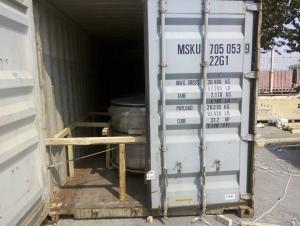Electrolytic Tinplate Coils
- Loading Port:
- China Main Port
- Payment Terms:
- TT OR LC
- Min Order Qty:
- -
- Supply Capability:
- -
OKorder Service Pledge
Quality Product, Order Online Tracking, Timely Delivery
OKorder Financial Service
Credit Rating, Credit Services, Credit Purchasing
You Might Also Like
Please kindly refer to Specifications:
Standard | JIS G3003,BS EN 10202 |
| Material | MR, SPCC |
Thickness | 0.15-0.50mm |
| Width | 600-1050mm |
| Temper | T1-T5; DR8 |
| Coating | Both Equal and Differential Available |
Surface finish | Bright, Stone, Silver, Matt |
| Oiling | DOS |
| Coil ID | 508 mm |
| Coil weight | 3-10 MT |
| Sheet weight | 1-1.5 MT |
| Weight in one 20’ container | 20-25 MT |
| Packaging | For coils: Anti-rust paper +metal cover +corner protected +wood skid For sheets: Thin plastic film +rust-proof paper +metal cover +metal angles + straps + pallet. Loaded in 20 feet container with max weight 25 tons |
| Application | Metal Container and Mechanical Parts |
- Q:What are the different methods of storing tinplate packaging?
- There are several methods of storing tinplate packaging, including stacking them on shelves or pallets, using storage bins or containers, hanging them on racks or hooks, or utilizing specialized storage systems such as gravity flow or carousel systems. The choice of method depends on factors such as available space, the quantity of packaging, ease of access, and the specific requirements of the packaging material.
- Q:Can tinplate be used for kitchenware?
- Yes, tinplate can be used for kitchenware. Tinplate is a type of steel coated with a thin layer of tin, which provides protection against corrosion and enhances its aesthetics. It is commonly used for making cans, containers, and other kitchen utensils like bowls, trays, and cooking pans. Tinplate is durable, easy to clean, and resistant to rust, making it suitable for various kitchen applications.
- Q:Raw material for zinc clad sheet? Can zinc clad plate replace tinplate?
- Zinc is very active, outdoor corrosion is the surface after the formation of Zinc Oxide, do you dare to drink drinks containing Zinc Oxide, you see, you can replace the tinplate?
- Q:How is tinplate tested for quality control?
- Tinplate is tested for quality control through various methods including visual inspection, measurement of coating thickness, adhesion testing, and corrosion resistance testing.
- Q:What are the common closure mechanisms for tinplate containers?
- The common closure mechanisms for tinplate containers include screw caps, snap-on lids, and lever-lid closures.
- Q:How is tinplate recycled and what are its recycling rates?
- Tinplate is recycled through a process called "tinplate recycling" where it is collected, sorted, and melted down to create new products. The recycling rates of tinplate vary depending on factors such as regional recycling infrastructure, collection efforts, and consumer awareness. However, on average, tinplate has a relatively high recycling rate of around 80-90% in many developed countries.
- Q:How is tinplate coated with polymer films?
- Tinplate is coated with polymer films through a process called lamination. This involves applying a layer of polymer film onto the surface of the tinplate using heat and pressure. The polymer film adheres to the tinplate, providing a protective barrier against corrosion and enhancing its durability.
- Q:How does tinplate perform in terms of durability and longevity?
- Tinplate is highly durable and long-lasting due to its corrosion-resistant properties. It can withstand harsh environmental conditions and is resistant to rust and oxidation, making it ideal for various applications where durability is crucial. Additionally, tinplate's longevity is further enhanced through proper coating and maintenance, ensuring its longevity even in demanding environments.
- Q:Can tinplate be used for packaging products with specific storage requirements?
- Yes, tinplate can be used for packaging products with specific storage requirements. Tinplate is known for its excellent durability, corrosion resistance, and ability to maintain product freshness and quality over time. It can provide an effective barrier against moisture, light, and oxygen, making it suitable for packaging products that require protection from these elements, such as food, beverages, cosmetics, and pharmaceuticals. Additionally, tinplate can be customized with various coatings and linings to meet specific storage requirements, ensuring the long-term preservation and safety of the packaged products.
- Q:How does tinplate perform in terms of UV resistance?
- Tinplate has limited UV resistance and may experience some degree of degradation when exposed to direct sunlight for prolonged periods.
1. Manufacturer Overview |
|
|---|---|
| Location | |
| Year Established | |
| Annual Output Value | |
| Main Markets | |
| Company Certifications | |
2. Manufacturer Certificates |
|
|---|---|
| a) Certification Name | |
| Range | |
| Reference | |
| Validity Period | |
3. Manufacturer Capability |
|
|---|---|
| a)Trade Capacity | |
| Nearest Port | |
| Export Percentage | |
| No.of Employees in Trade Department | |
| Language Spoken: | |
| b)Factory Information | |
| Factory Size: | |
| No. of Production Lines | |
| Contract Manufacturing | |
| Product Price Range | |
Send your message to us
Electrolytic Tinplate Coils
- Loading Port:
- China Main Port
- Payment Terms:
- TT OR LC
- Min Order Qty:
- -
- Supply Capability:
- -
OKorder Service Pledge
Quality Product, Order Online Tracking, Timely Delivery
OKorder Financial Service
Credit Rating, Credit Services, Credit Purchasing
Similar products
New products
Hot products
Hot Searches
Related keywords




























